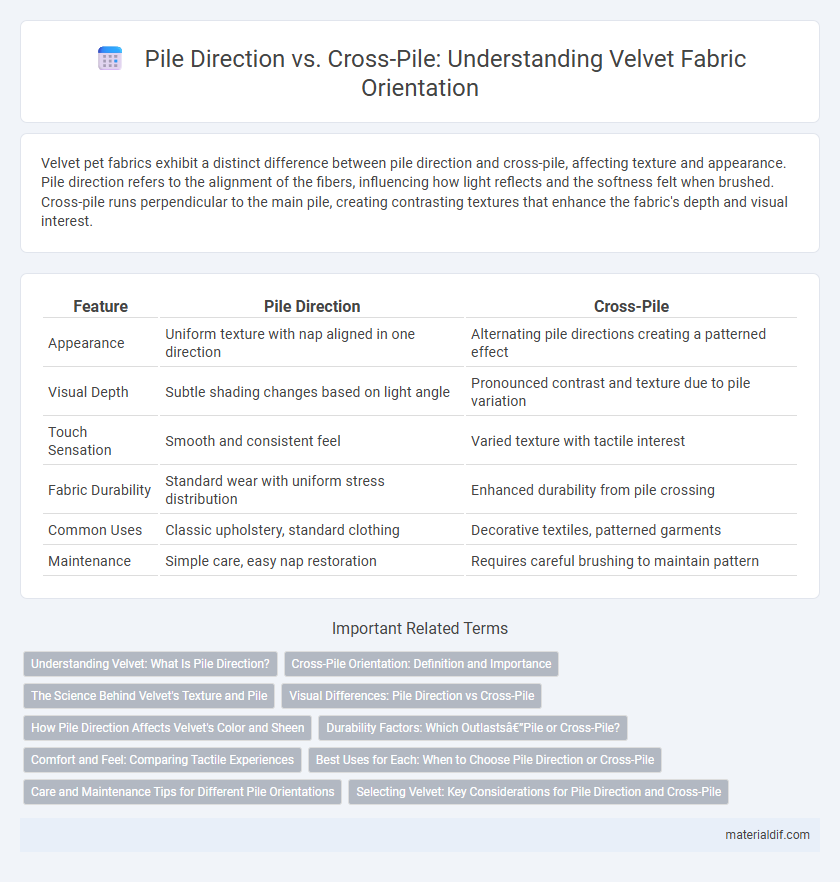Velvet pet fabrics exhibit a distinct difference between pile direction and cross-pile, affecting texture and appearance. Pile direction refers to the alignment of the fibers, influencing how light reflects and the softness felt when brushed. Cross-pile runs perpendicular to the main pile, creating contrasting textures that enhance the fabric's depth and visual interest.
Table of Comparison
| Feature | Pile Direction | Cross-Pile |
|---|---|---|
| Appearance | Uniform texture with nap aligned in one direction | Alternating pile directions creating a patterned effect |
| Visual Depth | Subtle shading changes based on light angle | Pronounced contrast and texture due to pile variation |
| Touch Sensation | Smooth and consistent feel | Varied texture with tactile interest |
| Fabric Durability | Standard wear with uniform stress distribution | Enhanced durability from pile crossing |
| Common Uses | Classic upholstery, standard clothing | Decorative textiles, patterned garments |
| Maintenance | Simple care, easy nap restoration | Requires careful brushing to maintain pattern |
Understanding Velvet: What Is Pile Direction?
Pile direction in velvet refers to the orientation of the fabric's raised fibers, which significantly influences its texture, appearance, and light reflection. Pile running in one direction (pile direction) creates a smooth, uniform sheen, while cross-pile velvet has fibers oriented in multiple directions, resulting in varied texture and color shifts. Understanding pile direction helps designers and consumers predict how velvet will look and feel under different lighting and usage conditions.
Cross-Pile Orientation: Definition and Importance
Cross-pile orientation in velvet refers to the alignment of the fabric's pile fibers perpendicular to the main grain, creating a distinctive texture and visual depth that enhances the fabric's luxurious appearance. This orientation affects the velvet's durability, sheen, and tactile experience, making it essential for designers to consider when selecting velvet for upholstery, apparel, or drapery. Proper understanding of cross-pile direction ensures optimal fabric performance and aesthetic appeal in high-end textile applications.
The Science Behind Velvet's Texture and Pile
Velvet's unique texture is largely determined by the orientation of its pile, with pile direction creating varying light reflections that result in different shades and tactile sensations. Pile runs in a consistent direction, producing a smooth, shiny surface, while cross-pile disrupts this alignment, yielding a more textured and matte appearance. This interplay between light absorption and diffraction due to pile orientation is foundational to velvet's depth and luxurious feel.
Visual Differences: Pile Direction vs Cross-Pile
Pile direction in velvet refers to the alignment of fibers running uniformly in one way, creating a consistent sheen and smooth surface that changes depth and color depending on the angle of light. Cross-pile velvet features fibers oriented in multiple directions, producing a more textured appearance with varied light reflection and a less uniform sheen. Visual differences between pile direction and cross-pile velvet significantly influence the fabric's luster, with pile direction offering a sleek, glossy look and cross-pile presenting a richer, more dynamic surface.
How Pile Direction Affects Velvet's Color and Sheen
Pile direction in velvet significantly influences its color intensity and sheen due to the way light interacts with the fabric's fibers. When viewed from different angles, velvet's pile can appear darker or lighter, creating a dynamic, rich appearance that enhances its luxurious look. Cross-pile velvet, where the pile runs in varying directions, often exhibits more pronounced shifts in hue and sheen compared to a uniform pile direction, adding depth and visual interest to the material.
Durability Factors: Which Outlasts—Pile or Cross-Pile?
Pile direction significantly influences velvet's durability, with pile velvet exhibiting longer wear resistance due to fibers aligned in a single direction reducing friction and abrasion. Cross-pile velvet, featuring fibers woven in multiple directions, tends to show quicker wear as the varied fiber orientation creates uneven stress points. Evaluating velvet textiles for high-traffic upholstery, pile direction generally outlasts cross-pile by maintaining fabric integrity and minimizing fiber matting over time.
Comfort and Feel: Comparing Tactile Experiences
Pile direction in velvet significantly influences its tactile feel, with pile running in one direction offering a smooth, uniform touch that enhances comfort. Cross-pile velvet creates a textured surface by crossing fibers, providing a plush, multidimensional sensation often perceived as richer and more luxurious. Understanding these differences helps in selecting velvet upholstery or clothing that best suits desired comfort and aesthetic preferences.
Best Uses for Each: When to Choose Pile Direction or Cross-Pile
Pile direction in velvet emphasizes the fabric's natural shine and texture, ideal for upholstery and drapery where light reflection enhances visual appeal. Cross-pile velvet, with fibers running perpendicular to the base weave, offers increased durability and a textured look, making it suitable for high-traffic areas and heavy-use furniture. Choosing pile direction velvet works best in decorative applications, while cross-pile velvet excels in functional, everyday use due to its resilience.
Care and Maintenance Tips for Different Pile Orientations
Velvet with pile direction requires gentle brushing in the nap's natural direction to maintain its smooth texture and luster, preventing matting or crushing. Cross-pile velvet demands careful handling by avoiding excessive friction and spot cleaning with mild detergents to preserve the pile's depth and sheen. Proper care tailored to pile orientation ensures the fabric retains its plush appearance and softness over time.
Selecting Velvet: Key Considerations for Pile Direction and Cross-Pile
Selecting velvet involves understanding the difference between pile direction and cross-pile, as pile direction refers to the way fibers lie and affect the fabric's appearance and texture. Pile direction impacts light reflection, with fabrics appearing darker or lighter depending on viewing angle, while cross-pile velvet features pile running in alternating directions, creating a distinctive pattern and added tactile interest. Choosing between pile direction and cross-pile velvet depends on the desired aesthetic effect, durability, and maintenance requirements for upholstery or fashion applications.
Pile Direction vs Cross-Pile Infographic

 materialdif.com
materialdif.com